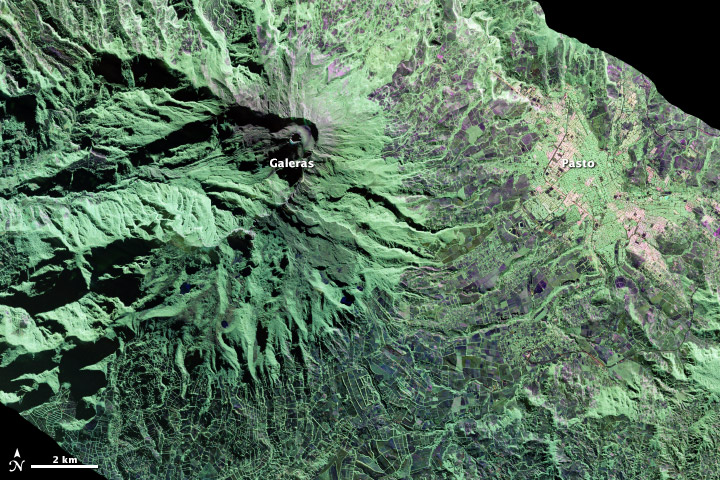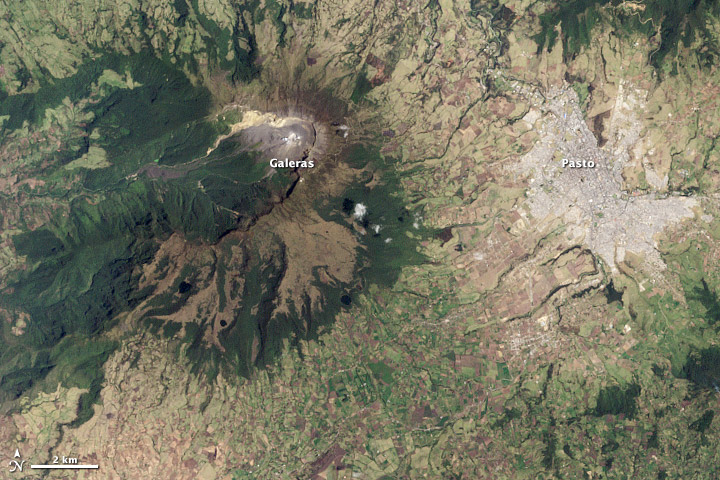NASA: Colombia - Pasto - Galeras Vulcan - Sizing Up Galeras - 30.05.13
Posted by Ricardo Marcenaro | Posted in NASA: Colombia - Pasto - Galeras Vulcan - Sizing Up Galeras - 30.05.13 | Posted on 15:44

acquired March 13, 2013
download large image (4 MB, JPEG, 4802x4133)

acquired October 14, 2002
download large image (2 MB, JPEG, 2130x1843)
When studying volcanoes, detecting
even the slightest movements of the land surface can tell a lot about
what is happening below. The ground rises and falls—expands and
contracts—with the movement of magma in subterranean chambers. But
detecting the amount and location of such subtle movements is difficult.
Remote sensing scientists at NASA’s Jet Propulsion Laboratory have a new tool to observe such ground deformation. The Uninhabited Aerial Vehicle Synthetic Aperture Radar (UAVSAR) sends pulses of L-band microwave energy from the sensor mounted on an aircraft to the ground. Those microwave signals bounce back to the sensor and get translated into a three-dimensional view of the surface, regardless of cloud- or tree cover.
UAVSAR captured the data for the top, false-color image on March 13, 2013, while flying on a NASA Gulfstream C-20A aircraft. The radar penetrated the tropical tree cover to detect the shape of the land surface around Galeras volcano and the city of Pasto, Colombia. UAVSAR uses microwaves instead of visible light to make images of the land surface at a spatial resolution of 6 meters (20 feet) per pixel.
For comparison, the second image shows roughly the same area in natural color on a rare cloud-free day in 2002, as observed by the Enhanced Thematic Mapper Plus (ETM+) on the Landsat 7 satellite. (The resolution of Landsat 7 is 30 meters per pixel.) Note how the UAVSAR image gives more sense of the three-dimensional structure and slope of the land.
By itself, a single UAVSAR image has some utility for studying soil moisture, vegetation cover, wetlands, and other landscape patterns, particularly in areas with a lot of cloud cover or dense forests. The real payoff for solid earth sciences comes from having two or more of these images, noted Naiara Pinto, UAVSAR science coordinator at JPL. “UAVSAR images can be used as part of a technique called InSAR—interferometric synthetic aperture radar—through which we can measure surface deformation to sub-centimeter accuracies.” By examining the interference patterns between multiple images, scientists can see the changes in Earth’s surface caused by volcanic deformation.
SAR instruments have been flown periodically on satellites and the space shuttle. “However, airborne studies allow us to measure crustal deformation with flexible time intervals and viewing geometry,” said Pinto. “You can learn more about the process and improve existing methodologies.”
Galeras was chosen for observation because of its proximity of the city of Pasto and because it has erupted several times over recent centuries, most recently in 2009–2010. The volcano has a breached caldera and an active cone that can produce explosive eruptions. “Galeras is a highly active volcano, and just one of many that we are targeting in order to establish baseline observations that will allow us to measure background levels of volcano activity and be in a position to respond in case of future large eruptions,” said Paul Lundren of JPL.
The research team will return to Galeras and to other locations in Central and South America in the spring of 2014. With that second round of measurements, Lundgren, Pinto, and others will be able to use interferometry to see if Galeras is changing.
Remote sensing scientists at NASA’s Jet Propulsion Laboratory have a new tool to observe such ground deformation. The Uninhabited Aerial Vehicle Synthetic Aperture Radar (UAVSAR) sends pulses of L-band microwave energy from the sensor mounted on an aircraft to the ground. Those microwave signals bounce back to the sensor and get translated into a three-dimensional view of the surface, regardless of cloud- or tree cover.
UAVSAR captured the data for the top, false-color image on March 13, 2013, while flying on a NASA Gulfstream C-20A aircraft. The radar penetrated the tropical tree cover to detect the shape of the land surface around Galeras volcano and the city of Pasto, Colombia. UAVSAR uses microwaves instead of visible light to make images of the land surface at a spatial resolution of 6 meters (20 feet) per pixel.
For comparison, the second image shows roughly the same area in natural color on a rare cloud-free day in 2002, as observed by the Enhanced Thematic Mapper Plus (ETM+) on the Landsat 7 satellite. (The resolution of Landsat 7 is 30 meters per pixel.) Note how the UAVSAR image gives more sense of the three-dimensional structure and slope of the land.
By itself, a single UAVSAR image has some utility for studying soil moisture, vegetation cover, wetlands, and other landscape patterns, particularly in areas with a lot of cloud cover or dense forests. The real payoff for solid earth sciences comes from having two or more of these images, noted Naiara Pinto, UAVSAR science coordinator at JPL. “UAVSAR images can be used as part of a technique called InSAR—interferometric synthetic aperture radar—through which we can measure surface deformation to sub-centimeter accuracies.” By examining the interference patterns between multiple images, scientists can see the changes in Earth’s surface caused by volcanic deformation.
SAR instruments have been flown periodically on satellites and the space shuttle. “However, airborne studies allow us to measure crustal deformation with flexible time intervals and viewing geometry,” said Pinto. “You can learn more about the process and improve existing methodologies.”
Galeras was chosen for observation because of its proximity of the city of Pasto and because it has erupted several times over recent centuries, most recently in 2009–2010. The volcano has a breached caldera and an active cone that can produce explosive eruptions. “Galeras is a highly active volcano, and just one of many that we are targeting in order to establish baseline observations that will allow us to measure background levels of volcano activity and be in a position to respond in case of future large eruptions,” said Paul Lundren of JPL.
The research team will return to Galeras and to other locations in Central and South America in the spring of 2014. With that second round of measurements, Lundgren, Pinto, and others will be able to use interferometry to see if Galeras is changing.
References
- NASA Jet Propulsion Laboratory Uninhabited Aerial Vehicle Synthetic Aperture Radar. Accessed May 28, 2013.
- Jet Propulsion Laboratory (2013, April 3) NASA Flies Radar South on Wide-Ranging Expedition. Accessed May 28, 2013.
- Jet Propulsion Laboratory How Imaging Radar Works. Accessed May 28, 2013.
- Smithsonian Institution Global Volcanism Program: Galeras. Accessed May 28, 2013.
Radar image by NASA
Jet Propulsion Laboratory/California Institute of Technology. Landsat
image created by Robert Simmon/NASA Earth Observatory, using Landsat
data provided by the U.S. Geological Survey. Caption by Michael Carlowicz.
- Instrument:
- Aircraft Sensors - UAVSAR
NASA: Colombia - Pasto - Galeras Vulcan - Sizing Up Galeras - 30.05.13
Ricardo M Marcenaro - Facebook
Blogs in operation of The Solitary Dog:
Solitary Dog Sculptor: byricardomarcenaro.blogspot.com
Solitary Dog Sculptor I: byricardomarcenaroi.blogspot.com/
Para:
comunicarse conmigo,
enviar materiales para publicar,
propuestas comerciales:
comunicarse conmigo,
enviar materiales para publicar,
propuestas comerciales:
marcenaroescultor@gmail.com
For:
contact me,
submit materials for publication,
commercial proposals:
For:
contact me,
submit materials for publication,
commercial proposals:
marcenaroescultor@gmail.com
My blogs are an open house to all cultures, religions and countries. Be a follower if you like it, with this action you are building a new culture of tolerance, open mind and heart for peace, love and human respect. Thanks :)
Mis blogs son una casa abierta a todas las culturas, religiones y países. Se un seguidor si quieres, con esta acción usted está construyendo una nueva cultura de la tolerancia, la mente y el corazón abiertos para la paz, el amor y el respeto humano. Gracias:)
(::)


Comments (0)
Publicar un comentario